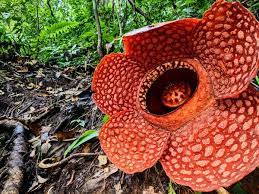Rafflesia Flower : Risk Of Extinction

Most species of the famously large Rafflesia flower are now at risk of extinction, new research warned recently.
- Rafflesia is a genus of parasitic flowering plants native to Southeast Asia.
- These plants are renowned for producing the largest individual flowers in the world, both in terms of size and weight.
- They are often referred to as “corpse flowers” due to their foul odour.
- They inhabit specialised localities in the tropical rainforests of Sumatra, Java, Borneo, Peninsular Malaysia, southern Thailand and the Philippines.
- There are 42 known species of Rafflesia, and the most famous species within this genus is Rafflesia arnoldii.
- They are massive and can reach up to 3 feet (almost 1 meter) in diameter and weigh up to 7 kg.
- They are parasitic, meaning they do not have leaves, stems, or roots like traditional plants.
- Instead, they depend on a host vine called Tetrastigma for nutrients and support.
- Rafflesia’s only visible part is the flower.




